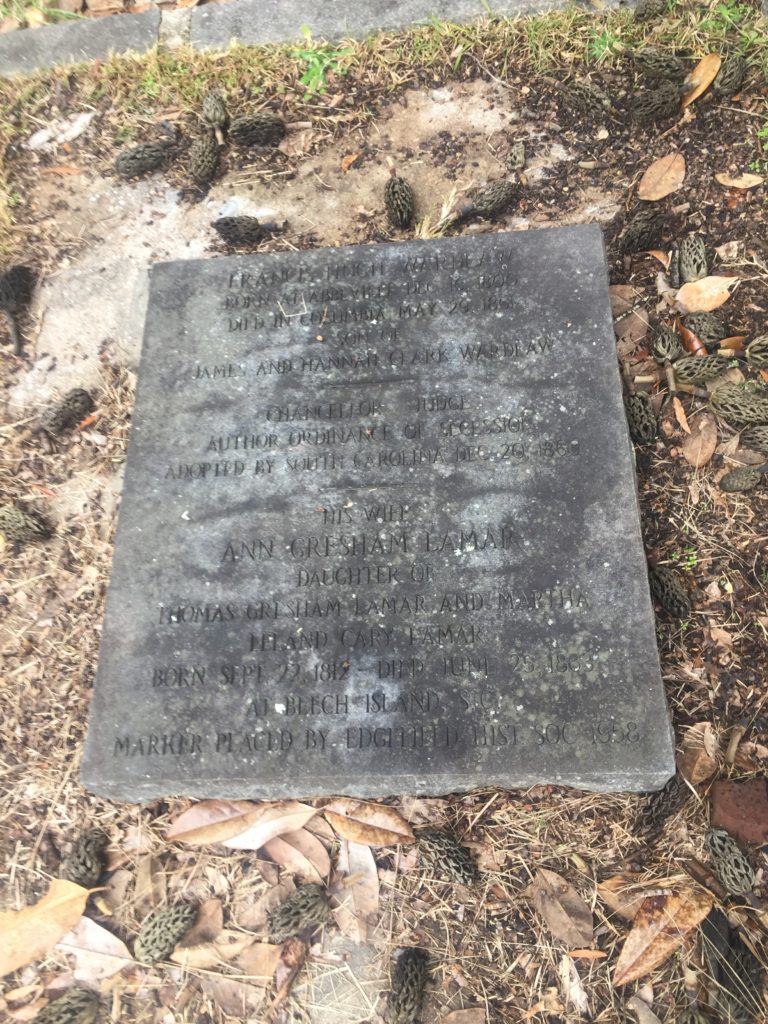Erik Visits an American Grave, Part 967
This is the grave of Francis Wardlaw.

It is rare that I have little to say on these grave posts. Francis Wardlaw was the author of the South Carolina Ordinance of Secession in 1860. No one did more to push forward Treason in Defense of Slavery than he. But there is nada on him in easily accessible public sources. This is really shocking. I can get some basic but boring facts out of old-timey and usually worthless local histories. Wardlaw was born in 1800 in Upper Long Cane, South Carolina. He grew up in the elite slaveholding class, going to the private schools that taught these elites the Latin and Greek that made them seem respectable. He went to school at South Carolina College and then became a lawyer in 1822, settling in Edgefield, the upcountry town that was becoming the center of South Carolina political life away from the heat of the lowcountry, largely because John C. Calhoun’s plantation was nearby. He edited a paper for a few years, served some time in the state legislature in the late 1820s and 1830s, and later was a judge.
None of this makes Wardlaw particularly significant I suppose. He’s just a middling South Carolina elite for the public memory. He had always supported treason. He was a member of the Nullification convention all the way back in 1832. People later remembered him as a paragon of this elite, not because of the offices he held but because of the way he carried himself–which if it is like other South Carolina elites was with a patrician air, a contempt for democracy, and a deeply held belief in white supremacy. But despite a not that memorable career generally, he did write the loathsome Ordinance of Secession. Since there’s not that much to say about Wardlaw per se, let’s just read this document:
We, the People of the State of South Carolina, in Convention assembled do declare and ordain, and it is hereby declared and ordained, That the Ordinance adopted by us in Convention, on the twenty-third day of May in the year of our Lord One Thousand Seven hundred and eighty eight, whereby the Constitution of the United States of America was ratified, and also all Acts and parts of Acts of the General Assembly of this State, ratifying amendment of the said Constitution, are here by repealed; and that the union now subsisting between South Carolina and other States, under the name of “The United States of America,” is hereby dissolved.
Other states were more specific with the reasons why they were committing treason in defense of slavery. South Carolina didn’t see the need to bother. Everyone knew.
Wardlaw died shortly after writing this, in 1861. One of his kids, a Confederate lieutenant, got killed in the war at Fort Moultrie, so that’s good.
The segregation academy in Edgefield created for whites after the forced integration of public schools? Oh yeah, it’s Wardlaw Academy.
Francis Wardlaw is buried in Edgefield Village Cemetery, Edgefield, South Carolina.
If you would like this series to visit other writers of key texts that promoted treason in defense of slavery, you can donate to cover the required expenses here. George Fitzhugh, writer of Cannibals All!, is in Huntsville, Texas, and Lucius Quintus Cincinnatus Lamar, writer of the Mississippi Declaration of Secession and later Secretary of the Interior under Cleveland, is in Oxford, Mississippi. Previous posts in this series are archived here.


